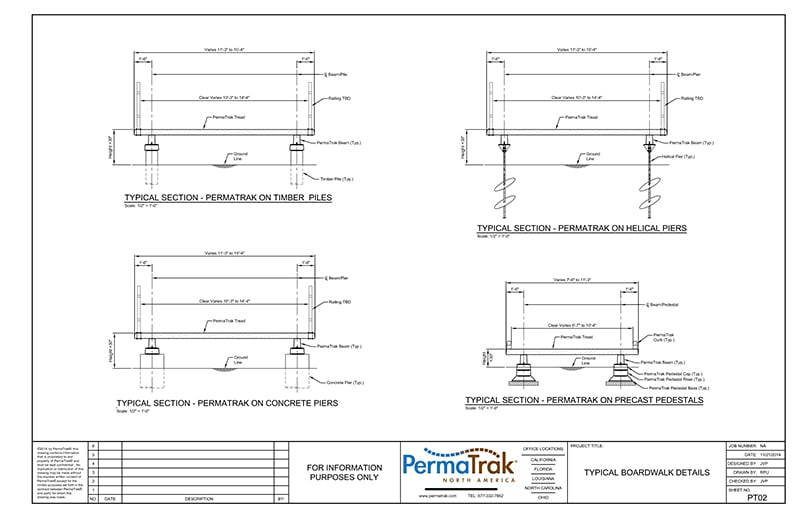Commercial Boardwalk Design Information

This page is dedicated to sharing more information about commercial boardwalk design. If you are looking for more information on residential decking products, the PermaTrak product is most likely not the right material for you.
If you'd like more design information specific to PermaTrak, please visit the PermaTrak System Page.
Loads and Codes
This section is meant to help designers find specific information during the design and specification process for a boardwalk system. Specifically, you can find information on designing a boardwalk system to meet:
- The specified live load requirement
- Applicable state and local design codes
Determining Boardwalk Live Load Requirements
The pedestrian live load for most PermaTrak boardwalks is 90 psf. However, there are applications where that live load needs to be increased or decreased based on the occupancy type (ex. concert stage will require heavier live load and a ramp will require lighter live load).
Our boardwalk design and engineering team is ready to assist landscape architects and engineers who are researching their boardwalk materials options. Please read below for more information on boardwalk design loads and governing design guidelines.
1. Pedestrian Live Load
- 60 psf (walkways and elevated platforms)
- 90 psf (bridge type application)
2. Vehicular Live Load
- Small maintenance vehicle (Gator)
- H-5 truck (10,000 lb. vehicle)
- Emergency vehicle (15,000 lb. ambulance or fire truck)
- H-10 truck (20,000 lb. vehicle)
- HL-93
3. Other Load Types
- Wind
- Seismic
- Snow
- Equestrian
Note: When our engineering team begins the boardwalk design process with you, we internally organize our structural calculations by first showing all the live loads options and referring to them as Case 1 (pedestrian), Case 2 (vehicular), Case 3 (emergency vehicle), etc. These case scenarios are pointed out on the right hand side of the page.
We run calculations through each case to determine the governing boardwalk live load requirement, because it's necessary to find the critical load case on the structure. A heavier vehicle doesn't necessarily mean it will be more detrimental to the boardwalk structure.
For example, lighter vehicles may put the majority of their the load on one concrete boardwalk tread, whereas other vehicle weights may be more spread out over a larger area. Boardwalk design engineers will analyze a vehicle's weight distribution, rather than the vehicle weight itself.
Determining the Governing Design Code
PermaTrak can be used as a durable boardwalk product for multi use trails, pedestrian bridges, observation decks, fishing piers, elevated greenways and more. To determine which design code to reference, you must first understand what type of structure you’re designing.
The vast majority of designers who we work with are specifying PermaTrak as a maintenance-free boardwalk product on greenways and multi use trails.
If a designer is working on a project with a ramp or observation deck, he or she will need to consult the usage table found within the International Building Code (IBC) or the local building code. This usage table will show different live loads for different occupancy types (ex. library floor vs. residential floor).
| Type of Application | Governing Design Code |
|---|---|
| Boardwalk, Swale Crossing, Multi Use Path, Bike Trail, Elevated Greenway | AASHTO LRFD Guide Specifications for Design of Pedestrian Bridges |
| Ramp, Deck, Observation Platform | International Building Code (IBC) or local building code |
| Vehicular Bridge | AASHTO LRFD Bridge Design Specification |
Vehicular Live Loads: Specific Boardwalk Design Vehicles
Below are several common boardwalk live load options that architects and engineers consider when designing a commercial boardwalk application. Most often, PermaTrak's concrete boardwalks fall into the Case 1 or Case 2 scenarios during the boardwalk design and engineering process.
 Parks and recreation maintenance crews often need to access their boardwalks with small vehicles. The PermaTrak system can cost-effectively be designed for such a live load.
Parks and recreation maintenance crews often need to access their boardwalks with small vehicles. The PermaTrak system can cost-effectively be designed for such a live load.
This John Deere vehicle pictured below represents a common live load design requirement for boardwalks: a John Deere Gator HPX 4×4 Diesel weighing 2,873 lbs. with a wheel base of 75.2 inches (direction of travel) and a 48-inch tire spacing per axle.
Another example of a small vehicular live load is a maintenance vehicle that weigh 5,000 lbs. - 2,500 lbs. per axle with a minimum 96-inch wheel base.
AASHTO H-5 vehicle weighing 10,000 lbs: 8,000 lb and 2,000 lb axles with a minimum 72-inch wheel base.
AASHTO H-10 vehicle weighing 20,000 lbs: 16,000 lb and 4,000 lb axles with a minimum 72-inch wheel base. See Table 3.2-1 below for a visual diagram.
This Table 3.2-1 shows a design vehicle to represent Case 2 and Case 4, respectively.

In rare cases where the boardwalk needs to support a heavy commercial vehicle, we have designed the PermaTrak system to meet a HL-93 live load requirement.
HL-93 represents a design vehicular live load case, not a specific vehicle.
The following information comes from Section 3.6.1.2.1 - General of AASHTO LRFD Guide Specification for Design of Pedestrian Bridges (2nd Edition).
"Vehicular live loading on the roadways or bridges or incidental structures, designated HL-93, shall consist of a combination of the:
- Design truck or design tandem, and
- Design lane load"
Other Resources
A set of guidelines around bicycle travel that intends to "provide guidance to designers and planners by referencing a recommended range of design values and describing alternative design approaches."
Guide for the Development of Bicycle Facilities, 4th Edition



